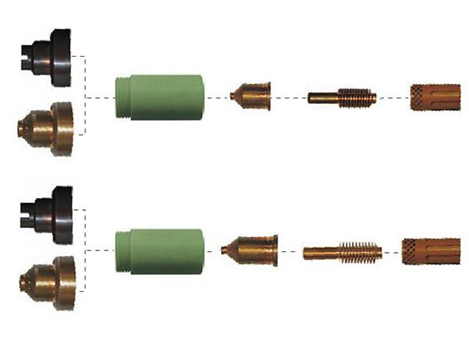This is a common question that our customers ask us. They want to know the difference between the two, and which cutting process is better for their application or end use. While the answer is't always set in stone, there are some general rules that separate the two processes.
Laser cutting and plasma cutting are both widely used thermal cutting processes in steel manufacturing. Each is used to cut metals for a variety of industries and applications. When deciding whether to laser or plasma cut stainless steel, several factors must be considered. These may include material thickness, type of material, complexity of the cut and required tolerances.
Each cutting solution has its advantages. Your manufacturer can help determine the best cutting solution for your application, but it is still important to understand the laser cutting and plasma cutting processes and understand the advantages each can offer to help you in your discussions.
.jpg)
Plasma Cutting Torch
Plasma Cutting
HD plasma cutting equipment allows beveling of parts as needed. Beveling is an important step in weld preparation, and larger or thicker parts require beveled edges to promote welded joints with the correct amount of melt depth. Because of this, plasma cutting is often a better choice for parts that need to be beveled for weld preparation, or for simple parts without complex geometry where exact tolerances are not as important.
Plasma cutting stainless steel offers many possibilities. It provides an efficient way to cut a variety of thicknesses and can cut plates into curved or angled shapes. Some of the advantages of plasma cutting stainless steel include
Automation.As a CNC (computer numerical control) cutting process, plasma cutting reduces the risk of human error over hand-held cutting methods.
Speed.Plasma cutting cuts up to five times faster than many comparable cutting methods. The process vaporizes the material being cut while cutting quickly.
Handling.Plasma cutting is the ideal method for rapid production of medium to high thickness stainless steel blanks. This cutting method is also suitable for low to medium thickness mild steel.
Reduced heat input. Plasma cutting can cut extremely hard metals, such as high strength or wear resistant steels, with lower heat input than other cutting methods.

Plasma Cutting Spare Parts
Laser Cutting
Laser Cutting Laser cutting is a precise thermal cutting process using a focused beam of light. This manufacturing process is recommended for applications where parts require tighter tolerances. When it comes to specific material selection, we work with our customers and in some cases make recommendations based on their specific application. We turn to laser cutting when parts have tight tolerance specifications, require precise cuts, or need holes that are small relative to the thickness of the material.
Laser cutting of stainless steel is a popular choice because of the many benefits it offers. Some of the most significant advantages of laser cutting include
Flexibility. Once the laser is set up and configured for a specific material type and thickness, it is easy to repeat cuts on multiple parts, sheets and plates without changing tools.
Accuracy. With typical cutting tolerances starting at +/- 0.015 inches, laser cutting is ideal for precise cuts.
Quality. Laser cutting produces parts with greater accuracy than other thermal cutting methods.
Repeatability. The consistently tight tolerances achieved by laser cutting ensure a high degree of repeatability from part to part.
Speed. Laser cutting can be faster than other traditional mechanical cutting processes, especially when making complex or extremely precise cuts.
Non-contact. With laser cutting, there is no mechanical friction causing tool wear. Only the laser is in contact with the material being cut.



.jpg)



